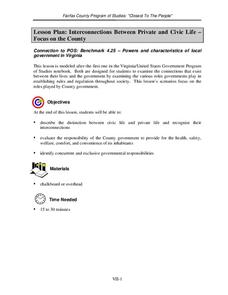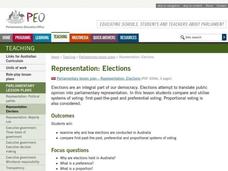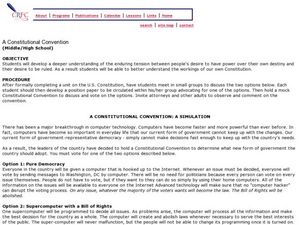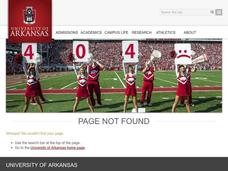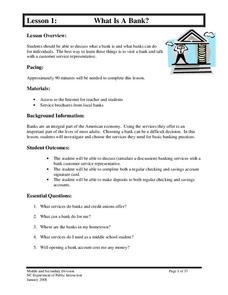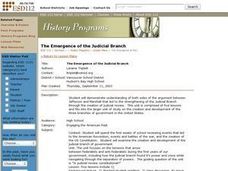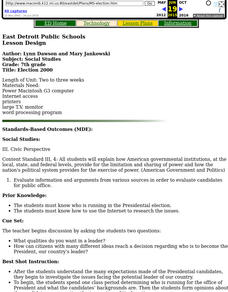Curated OER
Interconnections Between Private and Civic Life -- Focus on the County
Middle schoolers discuss the connections between their lives and the government. In groups, they examine the roles that governments have in different societies throughout the world. They role-play the roles of County members in...
Curated OER
Democracy: Participating in the Process
Pupils research all of the candidates running in an upcoming election. They interview them if possible and state their platforms. They organize a forum for the candidates to come and speak at their school.
Curated OER
Linking the Past with the Present
Fifth graders explore how Africans built South Carolina into an economic giant. They write an expository paper explaining how Africans and their descendants built the rice empire along the Carolina coastline. They write a persuasive...
Curated OER
Elections
Students examine why and how elections are conducted in Australia. They compare first-past-the-post, preferential and proportional systems of voting. Students brainstorm the names of elected representatives in the current federal...
Curated OER
Dealing with Chemical Emergencies
Learners examine how all levels of government react to chemical emergencies. They identify activities which could lead to an emergency. They discuss how they respond to contaminants released into the air.
Curated OER
A CONSTITUTIONAL CONVENTION: A SIMULATION
Pupils discuss two computerized options to change the current U.S. government. In this Constitutional Convention lesson plan, students write a statement advocating for one of the choices and participate in a mock modern Constitutional...
Council for Economic Education
A Penny Saved
A penny saved is a penny earned! Scholars research the different ways to save money over a lifetime. They investigate the Rule of 72, compound interest, and sub-prime loans to gain an understanding of how banks aid in the saving process....
Curated OER
What is Taxed and Why
Students are exposed to the need for federal, state and local governments to tax constituents to provide goods and services for their residents. They identify the different kinds of taxes and give examples of the goods and services taxed.
Curated OER
Breakdown
Students read reports and watch a video about World War I. In this World War I lesson plan, students discuss how the government has to take charge on many levels including the oil shortage during World War I.
Curated OER
George Washington Lives! On the Internet! - Thematic Unit
Students study all about George Washington: Farmer, Soldier, and First President of the United States of America on the internet.
Curated OER
What is a Court?
Students examine and discuss the judicial branch of the U.S. government. They define what a court is, list three characteristics of a trial court and an appellate court, and analyze various trial and appeal situations.
Curated OER
Who are Our Leaders?
Students discuss and identify current state and national leaders, and relate two specific details about them.
Curated OER
The Louisiana Purchase
In this Historical Facts activity, learners read a passage about the Louisiana Purchase and answer 8 fill in the blank and 7 true/false questions.
Curated OER
What's in the Water?
Students examine the Clean Water and Safe Drinking Water Acts. Using the text, they identify examples of how the federal and state governments implement public policy. They discuss how citizens can make sure that all levels of government...
Curated OER
Alaska's Current Issues
Students work in small groups to brainstorm a list of issues in Alaska. As a class, they discuss their concerns. Students place their issues in two lists, those that are in the domain of the local and state governments, and those that...
Curated OER
Technology (Post Lab): Utility Companies
Students study physics. For this utility company research lesson, students discover how their local utility company charges for electricity. They listen to a presentation and then conduct internet research to find more information on...
Curated OER
The Kansas-Nebraska Act of 1854: Popular Sovereignty and the Political Polarization over Slavery
High schoolers read selections from the Declaration of Independence, Northwest Ordinance of 1787, and the Wilmot Proviso of 1846. They contrast the maps of 1820 and 1854 to analyze developments in the national debate over slavery. They...
Curated OER
4th Grade Social Studies
In this social studies worksheet, 4th graders answer multiple choice questions about the Bill of Rights, Congress, the National Anthem, and more. Students complete 25 multiple choice questions.
Curated OER
How Did That Get There?
Students evaluate the role of government in addressing land use and other environmental issues. They analyze the powers, responsibilities, and limitations of elected and appointed officials in the national legislative, executive, and...
North Carolina Department of Public Instruction
What Is A Bank?
You're never too young to learn about banking and personal finance. Use a set of seven banking lessons to teach middle schoolers about checking and savings accounts, interest rates, loans and credit cards, and safety deposit boxes.
Curated OER
The Emergence of the Judicial Branch
Learners demonstrate understanding of both sides of the argument between Jefferson and Marshall that led to the strengthening of the Judicial Branch through the creation of judicial review.
Curated OER
Election 2000
Seventh graders explore issues facing the potential leader of our country, form opinions about the candidates representing the two major political parties, research election material and choose candidates, conduct debates, and vote in...
Curated OER
Uniform Blues
Fourth graders explore what the U.S. Constitution is and why it is important, the purpose of the state constitution, and its relationship to the U.S. Constitution and the similarities and differences among federal, state and local...
Curated OER
Who's Town is This, Anyway?
Fifth graders work in cooperative groups to simulate a town government as they consider an important change in their community growth. They analyze a real problem in the community and then determine their goals to fix it and make a...


